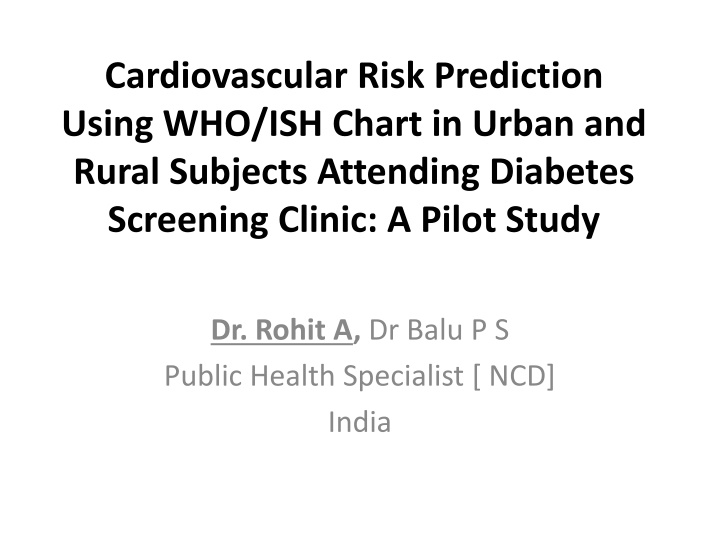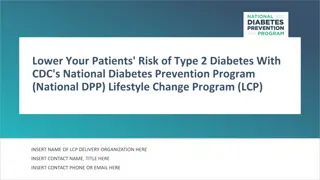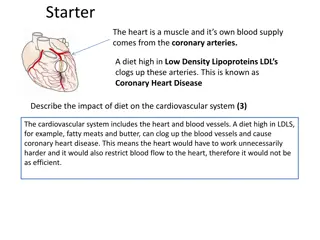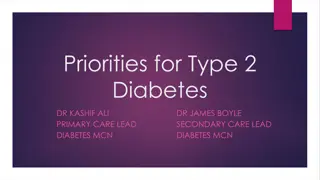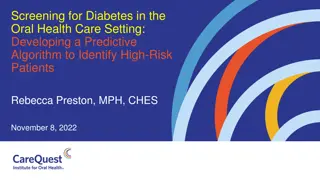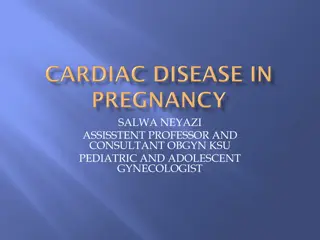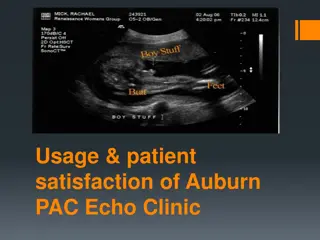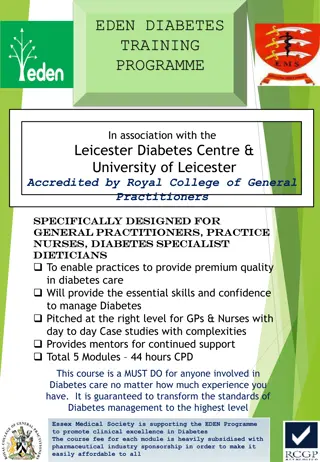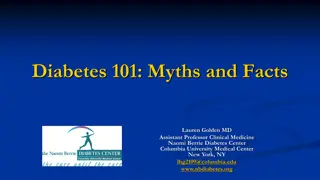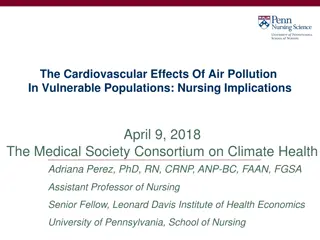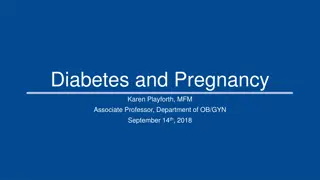Cardiovascular Risk Prediction Using WHO/ISH Chart in Diabetes Screening Clinic: A Pilot Study
Cardiovascular disease poses a significant risk to individuals with diabetes, leading to a high mortality rate. This pilot study aims to assess the 10-year cardiovascular risk in adults attending a diabetes screening clinic using the WHO/ISH risk prediction chart. The study focuses on urban and rural subjects and highlights the impact of diabetes on cardiovascular health, particularly in low- and middle-income countries. The community-based approach and study objectives are outlined in detail, along with the study design, population criteria, and methodology.
Download Presentation

Please find below an Image/Link to download the presentation.
The content on the website is provided AS IS for your information and personal use only. It may not be sold, licensed, or shared on other websites without obtaining consent from the author.If you encounter any issues during the download, it is possible that the publisher has removed the file from their server.
You are allowed to download the files provided on this website for personal or commercial use, subject to the condition that they are used lawfully. All files are the property of their respective owners.
The content on the website is provided AS IS for your information and personal use only. It may not be sold, licensed, or shared on other websites without obtaining consent from the author.
E N D
Presentation Transcript
Cardiovascular Risk Prediction Using WHO/ISH Chart in Urban and Rural Subjects Attending Diabetes Screening Clinic: A Pilot Study Dr. Rohit A, Dr Balu P S Public Health Specialist [ NCD] India
Cardiovascular Risk and Diabetes Cardiovascular disease is responsible for between 50% and 80% of deaths in people with diabetes. Diabetes increases the risk of heart disease and stroke. In a multinational study, 50% of people with diabetes die of cardiovascular disease (primarily heart disease and stroke) WHO projects that diabetes will be the 7th leading cause of death in 2030 Introduction
Community Based Approach Over three quarters of CVD deaths take place in low- and middle-income countries. People in low- and middle-income countries often do not have the benefit of integrated primary health care programmes for early detection and treatment of people with risk factors compared to people in high-income countries. NCDs already disproportionately affect low- and middle-income countries where nearly three quarters of NCD deaths Introduction
Objective To assess 10 year risk of a fatal or non-fatal cardiovascular event in adults attending diabetes screening clinic using WHO/ISH risk prediction chart Objective
Material and Methods Study design: Cross sectional Study setting: Disease[Diabetes] Davanagere district. Location: Urban: 1 [ District hospital] Rural : 2 [ Rural Primary health centres] Non screening Communicable Clinic of Material Methods
Material and Methods Study population: Adults aged more than 40 years Inclusion criteria: Age > 40 years Exclusion criteria: Pre existing heart condition Other major cardiac abnormality Age more than 80 years Material Methods
Material and Methods Study instrument: WHO/ISH Risk predictions charts to predict 10 year risk of a fatal or non- fatal cardiovascular event among the adults. [SEAR D] Study period: 27 July 14 August 2015 Data entry: Epidata3.1 Data analysis: IBMSPSS20.0. Material Methods
WHO/ISH Chart Categorizes individual subjects into cardiovascular risk Age Sex Smoking Diabetes status Systolic blood pressure Cholesterol level Material Methods
Results General Observation In relation to cardiovascular risk prediction Comparison Of Urban And Rural Comparison Of Male And Female Comparison Of Diabetics And Non Diabetics Comparison in relation to tobacco and other Results
Graph 1: Distribution Of Study Subjects Based On Location Location Rural, 54, 30% Urban Rural Urban, 127, 70% Results
Graph 2: Distribution Of Study Subjects Based On Gender Gender Male, 61, 34% Female Male Female, 120, 66% Results
Graph 3: Distribution Of Study Subjects Based On Tobacco Consumption Tobacco Consumption Tobacco yes, 22, 12% No Tobacco Tobacco yes No Tobacco, 159, 88% Results
Graph 4: Distribution Of Study Subjects Based On Diabetes Status Diabetes status Diabetics, 37, 20% Non diabetics Diabetics Non diabetics, 144, 80% Results
Graph 5a: Distribution Of Study Subjects Based On Cardiovascular Risk 30 to 40 %, 3, 2% Cardiovascular risk > 40 %, 6, 3% 20 to 30 %, 14, 8% < 10 % 10 to 20 % 20 to 30 % 10 to 20 %, 31, 17% 30 to 40 % > 40 % < 10 %, 127, 70% Results
Graph 5b: Distribution Of Study Subjects Based On Cardiovascular Risk Cardiovascular risk 140 < 10 %, 127 120 100 80 60 40 10 to 20 %, 31 20 to 30 %, 14 20 > 40 %, 6 30 to 40 %, 3 0 < 10 % 10 to 20 % 20 to 30 % 30 to 40 % > 40 % Results
Graph 5c: Distribution Of Study Subjects Based On Cardiovascular Risk 180 Less than 20 %, 158 160 140 120 100 80 60 More than 20 %, 23 40 20 0 Less than 20 % More than 20 % Results
Graph 6: Urban-Rural Comparison Of Cardiovascular Risk 120 Urban, 114 100 80 60 Rural, 44 40 20 Urban, 13 Rural, 10 0 Less than 20 % More than 20 % Results
Table 1: Urban-Rural Comparison Of Cardiovascular Risk Total P value > 0.05 Chi Square= 2.234 dF 1 Urban 114 Rural 44 158 Less than 20 % 23 13 10 More than 20 % 127 54 181 Results
Graph 7: Gender Wise Comparison Of Cardiovascular Risk 120 Female, 109 100 80 60 Male, 49 40 20 Male, 12 Female, 11 0 Less than 20 % More than 20 % Results
Table 2: Gender Wise Comparison Of Cardiovascular Risk Total P value < 0.05 Chi Square= 4.024 dF 1 Male 49 Female 109 158 Less than 20 % 12 11 23 More than 20 % 61 120 181 Results
Graph 8: Comparison Of Cardiovascular Risk Based on Diabetes Status Non diabetics, 135 140 160 120 100 80 60 Diabetics, 14 Diabetics, 23 40 Non diabetics, 9 20 0 Less than 20 % More than 20 % Results
Table 3: Comparison Of Cardiovascular Risk Based on Diabetes Status Non Total P value < 0.05 Chi Square= 26.479 dF 1 Diabetics 23 diabetics 135 158 Less than 20 % 14 9 23 More than 20 % 37 144 181 Results
Graph 9: Comparison Of Cardiovascular Risk Based on Tobacco Consumption 160 No Tobacco, 145 140 120 100 80 Consume tobacco, 9 60 Consume tobacco, 13 40 No Tobacco, 14 20 0 Less than 20 % More than 20 % Results
Table 4: Comparison Of Cardiovascular Risk Based on Tobacco Consumption Consume tobacco 13 Total P value < 0.05 Chi Square= 17.957 dF 1 No Tobacco 145 158 Less than 20 % 9 14 23 More than 20 % 22 159 181 Results
Discussion Risk of cardiovascular event increases Age Gender Diabetes Smoking Waist Hip Ratio Hypertension Location Studies from India and Abroad Discussion
Conclusion Categorizing people as low (<10%)/moderate (10%-20%)/high (>20%) risk is one of the crucial steps to mitigate the magnitude of cardiovascular fatal/non-fatal outcome Risk increase is compounded by modifiable and non modifiable factor. Diabetes management- cardiovascular risk counselling.
Recommendations WHO/ISH Risk Prediction Chart Evidence based Simple tool Used in community setting Training Counselling
References Global status report on noncommunicable diseases 2014. Geneva, World Health Organization, 2012. World Health Organization. Global Health Estimates: Deaths by Cause, Age, Sex and Country, 2000-2012. Geneva, WHO, 2014. Mathers CD, Loncar D. Projections of global mortality and burden of disease from 2002 to 2030. PLoS Med, 2006, 3(11):e442. Roglic G, Unwin N, Bennett PH, Mathers C, Tuomilehto J, Nag S et al. The burden of mortality attributable to diabetes: realistic estimates for the year 2000. Diabetes Care, 2005, 28(9):2130 2135. References
References Definition, diagnosis and classification of diabetes mellitus and its complications. Part 1: Diagnosis and classification of diabetes mellitus. Geneva, World Health Organization, 1999 (WHO/NCD/NCS/99.2). Morrish NJ, Wang SL, Stevens LK, Fuller JH, Keen H. Mortality and causes of death in the WHO Multinational Study of Vascular Disease in Diabetes. Diabetologia 2001, 44 Suppl 2:S14 S21. Global data on visual impairments 2010. Geneva, World Health Organization, 2012. Global status report on noncommunicable diseases 2010. Geneva, World Health Organization, 2011. References
Acknowledgement Dr Alur Manjunath, Principal, JJM Medical College Dr Balu P S, Professor, JJM Medical College Dr Manu A S, JJM Medical College KHSDRP, Karnataka Department of Health and Family Welfare, Davanagere District
